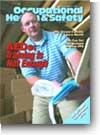
December 2004
Cover Story
By Frank J. Poliafico, RN
AT one time or another, most of us have secretly harbored the thought--or even boldly uttered the words--"If I were in charge around here, I'd _____ _____ ____ ____." (You can fill in the blanks yourself.) As for me, having been the only male in my class in nursing school, having fathered two (now grown) daughters, and having been married for more than 30 years, I long ago gave up any desire or hope of ever occupying a position of control or authority over anything or anyone.
Features
By Kevin Murphy
AS a safety products distributor, keeping focused on filling the order is Job One: Answer the phone, determine the need, agree on price, and fill the order. That's what keeps distributors in business, right?
By Bob Durstenfeld
IT is a debatable question whether people feel any safer now than they did three years ago. We are certainly more aware of the threats, but have our responses scaled with the threat?
By Bill Clendenen, A.B., MBA, Bill Rowe
A co-worker in his early fifties collapses from sudden cardiac arrest (SCA) after taking a walk during his break. He's unresponsive, turning blue, and lying motionless on the floor just inside the main entrance. You activate your emergency response plan, call 911, and wait. Within three minutes, CPR is started by trained co-workers. Six minutes later, EMS arrives and begins advanced care.
By Frederick G. Heath
STANDARDS for manufactured products provide a welcomed accountability to the marketplace and make purchasing decisions easier--or do they?
By Chris Webre
PALMS sweating, smelling burnt rubber, feel the power, getting hot, c'mon c'mon, let's go, sweating more, yellow lights--feel the rush, pedal to the metal, ZOOOOOM. Does this sound like your fork truck driver? While this may get a chuckle, speeding fork trucks and dock safety do not go hand in hand.
By Joe Lorenz, David Vicarel
PCE--the acronym used in the hazardous materials industry for tetrachloroethene--is a common dry-cleaning solvent that does wonders for getting clothes clean.
By Wayne Vanderhoof
IT is a never-ending battle to get workers to wear any type of personal protective equipment. All types of PPE have their advantages and disadvantages, comforts and discomforts. Getting workers to use it is an endless task.
By Rebecca Nigel
AS a manager and leader, how credible are you? Put another way, how much do your employees trust you: your decisions, what you advocate, and even what you say?
By Mary Lesch
INTENDED to remind workers of safety hazards, warning signs are not necessarily the quick and easy safety reminders they are supposed to be.
Departments
By Jerry Laws
I'D be the last person to recommend betting the house on an unscientific poll, but some of them are useful. It seems you and I agree: OSHA should divide into two separate units, one for enforcement and the other to perform consulting functions.
By Scott A. Kuebler, Ph.D., CHSP, CHS-III, CECD
OSHA's injury, illness, and inspection rates for 2001 lend credence to its stance that strict enforcement of standards, along with intensive education and development of alliances in the business community, is the winning prescription for the safety and health of American workers.
By Ronnie Rittenberry
LIFE is full of surprises. They can either take our breath away with delight or kick us in the head with steel-toed work boots--or worse. If it's your birthday or you work at a place that actually grants promotions, then, hey, surprises can be good.